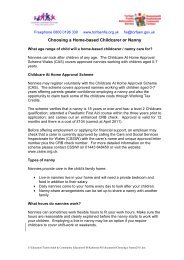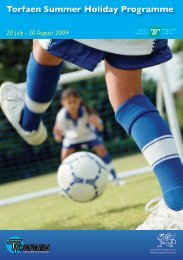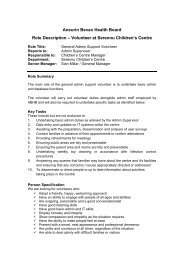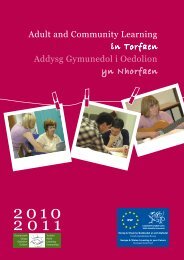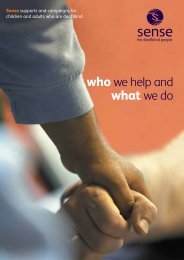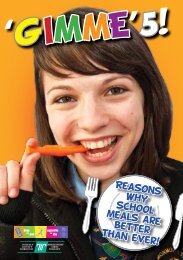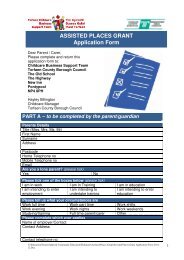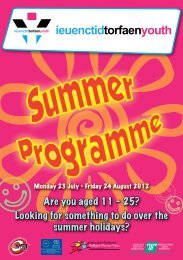Food and Health Guidelines - Torfaen Family Information Service
Food and Health Guidelines - Torfaen Family Information Service
Food and Health Guidelines - Torfaen Family Information Service
Create successful ePaper yourself
Turn your PDF publications into a flip-book with our unique Google optimized e-Paper software.
6. Menu Planning<br />
<strong>Guidelines</strong> for caterers:<br />
• Always wash your h<strong>and</strong>s before <strong>and</strong><br />
after preparing food.<br />
• Never use cutlery for more than one<br />
dish without washing it first.<br />
• Mop up spillages quickly.<br />
• Avoid cross contamination.<br />
• Use separate utensils for allergy diets.<br />
• Aim for special diets to look like regular<br />
choices.<br />
For information on peanut allergy, milk<br />
allergy <strong>and</strong> gluten free diets see Appendix 5.<br />
Vegetarianism<br />
Vegetarianism can be divided into four<br />
main groups:<br />
• Partial vegetarian - red meat <strong>and</strong> offal are<br />
excluded but may still eat chicken <strong>and</strong>/<br />
or fish.<br />
• Lacto-ovo vegetarian - red meat, offal,<br />
poultry, <strong>and</strong> fish are excluded. Children will<br />
eat milk <strong>and</strong> eggs.<br />
• Lacto-vegetarian - red meat, offal, poultry,<br />
fish <strong>and</strong> eggs are excluded. Children will<br />
eat milk containing foods but not eggs.<br />
• Vegans - all animal products are avoided.<br />
Vegetarian diets<br />
Babies <strong>and</strong> young children can obtain a<br />
nutritionally adequate vegetarian diet if a<br />
wide variety of foods are eaten. Remember<br />
to include foods from the four main food<br />
groups each day. However, the greater the<br />
degree of dietary restriction, the greater the<br />
risk of nutritional deficiency.<br />
To ensure a healthy diet:<br />
• Encourage regular meals <strong>and</strong> snacks.<br />
• Choose alternatives sources of protein<br />
to meat <strong>and</strong> fish such as eggs, soya<br />
products (e.g. soya mince, tofu), beans<br />
including baked beans, chick peas,<br />
lentils, chopped nuts <strong>and</strong> nut spreads.<br />
All these foods contain iron, which is the<br />
main nutrient at risk in a vegetarian diet.<br />
• Other sources of iron containing foods<br />
to include are fortified breakfast cereals,<br />
bread, especially wholemeal, green<br />
leafy vegetables <strong>and</strong> dried fruit.<br />
• Fruit, fruit juice <strong>and</strong> vegetables should<br />
be included, as they are rich in vitamin<br />
C, which enhances the uptake of iron<br />
from non meat sources in the body.<br />
• Include energy dense foods<br />
e.g. spreading fats <strong>and</strong> cooking oils,<br />
seed <strong>and</strong> nut butters, cheese, avocados,<br />
dried fruit <strong>and</strong> houmous.<br />
• Ensure an adequate calcium intake<br />
by offering milk, cheese, yoghurt <strong>and</strong><br />
fromage frais on the menu.<br />
• If cheese is served at the main course at<br />
lunchtime include a protein containing<br />
iron at the other main meal, for example<br />
beans, lentils or eggs.<br />
16




